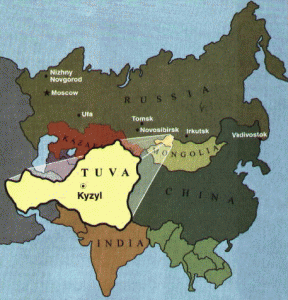
Alash Ensemble – Tuvan Throat Singing – Comes to Swallow Hill this Friday, April 6
April 5, 2012
Alash Ensemble onstage recently (Photo: Alash)
If you’ve heard it, chances are you’re either mesmerized by its outlandish beauty, haunted by its sweeping sonics or fascinated by the physics. Either way, there’s not another vocal style that’s anything quite like Tuvan throat singing. And there’s no touring troupe that pulls it off like the Alash Ensemble. Four native Tuvans, Alash have been practicing the south-Siberian country’s native music for most of their lives, and have toured the world spreading its singular attraction for the past decade or so. They’re landing in Denver this Friday night, April 6th, and will be performing at Swallow Hill Music (71 East Yale Avenue, Denver, Colorado, 80210) in a setting that’s perfect to close your eyes and imagine the landscapes and expanses in which the sounds were born.

Tuva
Tuvan throat singing, also called overtone singing, is a practice in which the singer manipulates his or her vocal chords, resulting in a sound that covers as many as four distinct notes – in different signatures, covering bass, rhythm and high-pitched melodies at times – all at the same time. And this is without the use of any electronic assistance – particularly not the dreaded and accursed auto-tune (kinda puts Western Pop “singers” in a different light, huh? Wonder how Steven Tyler, J-Lo and the gang would rate this quartet?). The result is a hauntingly beautiful mixture of sounds that – in an attempt to describe it in more familiar terms – approximates bagpipes, but without the sometimes gratingly high-pitched squeals (at least overall).

A map of Tuva’s location.
The origins of this style of singing are lost to history, but its progenitors are said to have developed it even before language, and to have created it to mimic the sounds of nature. Considering the region from which it emanates – Tuva is an extremely remote country tucked between the northern border of Mongolia and the southern border of Siberia – and its immense, wide and windswept, dramatic valleys, steppes and mountain ranges, it makes sense that it would sound as it does. It is said by the Tuvan people that their folk music was developed to carry their voices over the long distances characteristic of their homeland, and drew inspiration from their largely animist beliefs – and they succeed in portraying the wind, water and animals of that land.
Alash combine their native music with Tuvan instruments, and often with a slight nod to Western constructions, but they never lose sight of the beautiful, haunted tones and breathtaking sounds of throat singing. Don’t miss this chance to see and hear such a unique experience this Friday night.

Alash Ensemble
I got the chance to communicate with Alash this past week, via email, about Tuvan throat singing, and a few more things. Read on to get a glimpse….
DenverThread: Obviously throat singing is a technique that takes years to learn – or is it? Do the members of the Alas Ensemble possess a talent that not all people of Tuva – or all humans, for that matter – possess, and did throat singing come to you easily?
Alash: Throat singing is practiced by more people in Tuva than you might think (it’s not a special art reserved for just a few) probably about 30-40 percent of men have some skill it. Like any instrument you can kind of get the knack of it fairly quickly but it takes years to master, especially to the level that Alash has. It came to them easily in the sense that conditions were ripe for them to learn themselves – Bady can’t remember not being able to throat sing, Ayan-ool started in 1st grade and Ayan a little later.
DT: To many in the west who have been exposed to “throat singing,” or “overtone singing,” it has come by way of Tibetan Buddhism. But the Tuvan tradition of throat singing isn’t tied to Buddhism – but is rather an outgrowth of Tuvan culture – is that accurate? What would you say are the origins of the practice?

A Tuvan child in winter.
Alash: Ted Levin makes the claim that throat singing comes from a time in human history prior to or contemporaneous with the development of language. It’s part of the fabric of Tuvan culture. Maybe more peoples used to sing in this manner but most of us have forgotten how to do it and the tradition has remained unbroken in Tuva. That would not surprise me. IT also wouldn’t surprise me to hear that the Tibetan Buddhists heard the Tuvans singing and brought kargyraa back to Tibet with them.
DT: Does the current culture in Tuva also relate throat singing with Buddhism, in the sense of learning the singing method, practicing, training, etc.? Or does it exist as a folk practice, regardless of religion?
Alash: It is one hundred percent purely the folk music of the Tuvan people.
DT: It is said that throat singing is an attempt to “mimic nature’s sound,” and comes from the tradition of animism in Tuva. Is that still true today? Is there any tradition that one would follow from a young age, perhaps, to become a throat singer, or is it something anyone can learn?
Alash: Anyone can learn it as evidenced by the great number of non-Tuvans who have taken it up in the wake of Tuvan’s emergence onto the world stage. However, they often differ from a native born Tuvan in some ineffable way. This is most likely due to not growing up in the specific sound environment of Tuva and being raised to hear in the way that Tuvans, living nomadically, traditionally had. Even our band members, who went to school in the city of Kyzyl, still spent great amounts of time at their relatives’ herding camps, especially in summer.

Expansive landscapes of Tuva may have been the origin of “throat singing.”
DT: Alash has incorporated some western traditions into their performances and music – how much of what Alash creates remains within the Tuvan folklore, and how much of it is based in Western tradition? Of course, I assume it’s mixed with some Western influence in part to appeal more easily to Western ears – but how different would what one hears on the plains or peaks in Tuva be from what we can get here on record/CD?
Alash: Well, the thing is now the people who are singing in the plains and peaks of Tuva have been listening to the same things we have, as well as listening to Alash and Huun-Huur-Tu etc. so you might be likely to hear an Alash type of arrangement out there or worse yet you’ll hear one of many not-so-great Tuvan pop songs more than likely. If you take an older person or look at the way the music sounded when people started to record it, you are talking about differences such as: people didn’t perform in ensembles like this with arrangements, long pauses between breaths of throat singing, singers who might not sing in all the styles but specialize in a few styles or instruments … older igil playing for instance often sounds ‘rawer’ then it does nowadays because the modern guys are more familliar and in tune with the tempered scale … but that ‘rawness’ is a richness of overtones and textures that once you learn to hear is truly awe inspiring.
DT: What’s the story of Alash, in a nutshell (aside from the standard Wiki-bio and what can easily be found online)? Is there any relation, for instance, to the early 20th Century meanings behind “Alash” – the short-lived Alash Autonomy, or the Kazakhs, or their democratic party from the teens?
Alash: No relation to Kazakhstan. Alash is a river in w Tuva that runs in to Xemchik which runs in to Yenisei. When they picked the name they like the symbolism of the river – they receive from the pass, flow with the present, and pass on into the future, like the flow of the river from ancestors to future. They met in 1999 at Kyzyl Arts College, used to be a bunch of guys who all had interest in trad music but over two semester narrowed down to main 6 guys, which they were solidly in (tho often performing in some combination of 3 or 4 depending on who was available), over the course of the school years played like this then 2 guys left and got oother jobs, narrowed down to 4 and been going strong ever since then, tho Mai-ool left in 2007 and he was replaced by Nachyn.

